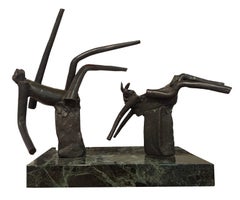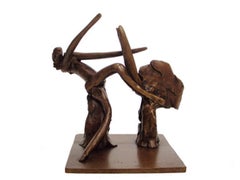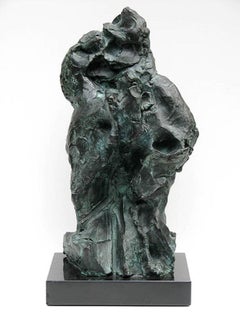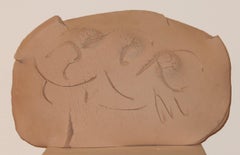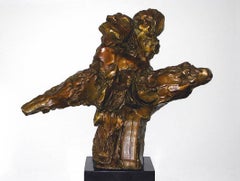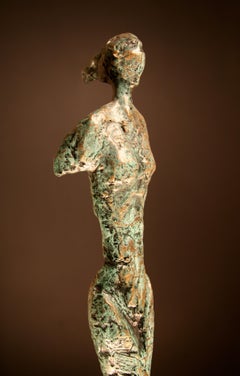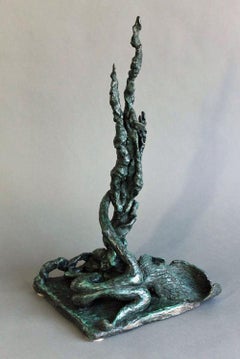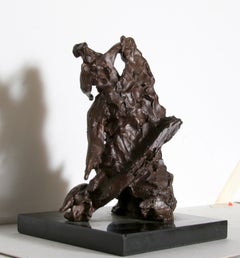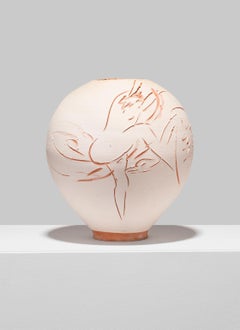Reuben Nakian Sculptures
to
5
2
Overall Width
to
Overall Height
to
7
4
1
4
2
1
2
1
1
1
1
5
5
2
2
1
28
214
196
161
132
7
Artist: Reuben Nakian
Leda and the Swan, Bronze Sculpture by Reuben Nakian
By Reuben Nakian
Located in Long Island City, NY
A bronze sculpture by Reuben Nakian from 1978. An abstract-figurative sculpture representing the Greek myth of Leda and the Swan- in which the Greek god Z...
Category
1970s Expressionist Reuben Nakian Sculptures
Materials
Bronze
"Nymph and Goat" Modern Abstract Mythological Bronze and Marble Sculpture
By Reuben Nakian
Located in Houston, TX
Modern abstract sculpture of a woman and goat by renowned artist Reuben Nakian. The work features a female nymph figure lying back as a goat figure approaches in Nakian's iconic bloc...
Category
1980s Abstract Reuben Nakian Sculptures
Materials
Granite, Bronze
Leda and the Swan, Ed. 1/9
By Reuben Nakian
Located in Greenwich, CT
Classical mythology is fraught with stories of sexual misdeeds by Zeus, King of the Gods. Often Zeus would fall in love with a mortal woman and then transform himself into an animal ...
Category
1970s Abstract Reuben Nakian Sculptures
Materials
Bronze
Juno
By Reuben Nakian
Located in Greenwich, CT
Abstract sculpture of the ancient Roman goddess Juno.
Artist's proof.
The powerful legacy of Reuben Nakian has earned him a coveted place in the ...
Category
Mid-20th Century Modern Reuben Nakian Sculptures
Materials
Bronze
$15,000
Abstraction
By Reuben Nakian
Located in Greenwich, CT
Abstract terracotta sculpture
Category
1970s Abstract Reuben Nakian Sculptures
Materials
Terracotta
Goddess with the Golden Thighs, maquette
By Reuben Nakian
Located in Greenwich, CT
Abstract bronze by Reuben Nakian
Edition of 9
The powerful legacy of Reuben Nakian has earned him a coveted place in the history of American art. No other sculptor of the twentieth ...
Category
Mid-20th Century Modern Reuben Nakian Sculptures
Materials
Bronze
Abstraction
By Reuben Nakian
Located in Greenwich, CT
Abstract terracotta sculpture
Category
1970s Abstract Reuben Nakian Sculptures
Materials
Terracotta
Related Items
Bronze Sculpture “Arise”
By Frank Arnold
Located in Fresno, CA
Frank Arnold is thought by many to be one of the foremost abstract figurative painters and sculptors of our time. He is a living master whose work is considered to be both personal a...
Category
2010s Abstract Reuben Nakian Sculptures
Materials
Bronze
Woman Lying Down & Growing with Tree bronze sculpture by Yulla Lipchitz
Located in Hudson, NY
Organic, abstract bronze sculpture by Yulla Lipchitz of a woman lying down with a tree.
About this artist: Yulla Lipchitz, née Halberstadt, was born on April 21, 1911 in Berlin, Ge...
Category
1970s Modern Reuben Nakian Sculptures
Materials
Bronze
$3,775
H 16 in W 7 in D 8 in
Anatomical 3/50 - smooth, black, granite, indoor/outdoor, figurative sculpture
By Jeremy Guy
Located in Bloomfield, ON
Smooth-surfaced, black granite has been engineered and sculpted into an elegant and classic depiction of a human figure by Jeremy Guy. The formalist play of positive and negative spa...
Category
2010s Abstract Reuben Nakian Sculptures
Materials
Stone, Granite
$15,500
H 48 in W 20 in D 12 in
Eugene Caples "Bronze Sculpture I" Abstract Bronze Sculpture
By Eugene Caples
Located in Detroit, MI
This small exquisite "Bronze Sculpture I" is in excellent condition and a perfect example of Eugene Caples craftsmanship. Although it is mainly abstract, there are bits that look figurative either an arm or a leg attempting to emerge from a fold or attempting to hold a pose such as in yoga. It cries out to be touched and held, looked at and caressed. The beautiful patina on the surface gives voice to the many hands that have done these things.
Eugene Caples is a designer and craftsman who worked in Kansas City in the 1960s and later through the early 21st century. He attended the Kansas City Art Institute, earning his Bachelors of Fine Arts in Industrial Design in 1959. In 1963 he was accepted to Cranbrook Academy of Art, Bloomfield Hills, Michigan. The Cranbrook Academy of Art was designed by architect and faculty member, Eliel Saarinen who collaborated with Charles and Ray Eames on chair and furniture design. Numerous creative artists are alumni of Cranbrook and include: Harry Bertoia, Florence Knoll, Jack Lenor Larsen, Donald Lipski, Duane Hanson, Nick Cave, Hani Rashid, George Nelson, Urban Jupena (Nationally recognized fiber artist), Artis Lane (the first African-American artist to have her sculpture, "Sojourner Truth," commissioned for the Emancipation Hall in the Capital Visitor Center in Washington DC), Cory Puhlman (televised Pastry Chef extraordinaire), Thom O’Connor (Lithographs), and Paul Evans (Created Brutalist-inspired sculpted metal furnishings.)
Gene worked...
Category
Late 20th Century American Modern Reuben Nakian Sculptures
Materials
Bronze
$1,950
H 6.5 in W 2.75 in
Mujer Agachada (Crouching Woman), 1972, (III/VI)
By Felipe Castañeda
Located in San Francisco, CA
Felipe Castañeda
Mujer Agachada (Crouching Woman), 1972
Bronze, wood base
12 x 9.5 x 11.5 inches
Edition III/VI
Most recent owners acquired this limited-edition bronze sculpture fro...
Category
Late 20th Century Expressionist Reuben Nakian Sculptures
Materials
Bronze
$12,000 Sale Price
20% Off
H 12 in W 9.5 in D 11.5 in
Latin American Sculpture by Raúl Valdivieso
By Raúl Valdivieso
Located in Washington, DC
Bronze sculpture by Latin American sculptor Raúl Valdivieso (Chilean, 1931-1993). Valdivieso is known for his reinterpretation of the classic organic forms and human figures.
Raúl Valdiveso was born September 9, 1931 in Santiago, Chile. In 1952 he began his studies at the School of Fine Arts at the University of Chile. There he took to sculpture and studied under professors like Marta Colvin...
Category
1960s Abstract Reuben Nakian Sculptures
Materials
Bronze
$2,660 Sale Price
30% Off
H 23 in W 14.5 in D 11.5 in
David Hostetler Polished Bronze Female Form Bust Feminine Shiny Gold Egyptian
By David Hostetler
Located in Nantucket, MA
This polished bronze bust is sealed with Glasurit- a car finish that is baked on. It prevents the sculpture from tarnishing or yellowing. All you need to do is dust with a soft cloth. This bust is from a full figure wood sculpture...
Category
1970s Modern Reuben Nakian Sculptures
Materials
Bronze
$5,900
H 11.5 in W 7 in D 4 in
German Expressionist Bronze Relief Plaque Mans Best Friend, a Man and His Dog
Located in Surfside, FL
Mans Best Friend
C.M. Junghans
1985
This is done in a German Expressionist style. It is bronze over some sort of fill. It depicts a man gentleman and his dog. a Cocker Spaniel or Co...
Category
20th Century Expressionist Reuben Nakian Sculptures
Materials
Bronze
$850
H 16 in W 10.5 in D 1.5 in
Eugene Caples "Bronze Sculpture II" Abstract Bronze Sculpture
By Eugene Caples
Located in Detroit, MI
This small exquisite "Bronze Sculpture II" is in excellent condition and a perfect example of Eugene Caples craftsmanship. This is mainly abstract with some graphic or architectural elements and is so delightful that mythical creatures demand to be considered. It cries out to be touched and held, looked at and caressed. The beautiful patina on the surface gives voice to the many hands that have done these things.
Eugene Caples is a designer and craftsman who worked in Kansas City in the 1960s and later through the early 21st century. He attended the Kansas City Art Institute, earning his Bachelors of Fine Arts in Industrial Design in 1959. In 1963 he was accepted to Cranbrook Academy of Art, Bloomfield Hills, Michigan. The Cranbrook Academy of Art was designed by architect and faculty member, Eliel Saarinen who collaborated with Charles and Ray Eames on chair and furniture design. Numerous creative artists are alumni of Cranbrook and include: Harry Bertoia, Florence Knoll, Jack Lenor Larsen, Donald...
Category
Late 20th Century American Modern Reuben Nakian Sculptures
Materials
Bronze
$1,950
H 4.75 in W 4 in
Large Bronze Sculpture "Virtuoso" Figure American Boston Figural Modernist
By David Aronson
Located in Surfside, FL
Aronson, David 1923-
David Aronson, son of a rabbi, was born in Lithuania in 1923 and immigrated to America at the age of five. He settled in Boston, Massachusetts where he studied at the school of the Museum of Fine Arts under Karl Zerbe, a German painter well known in the early 1900s. Aronson later taught at the school of the Museum of Fine Arts for fourteen years and founded the School of Fine Art at Boston University where he is today a professor emeritus. An internationally renowned sculptor & painter, Aronson has won acclaim for his interpretation of themes from the Hebrew Talmud and Kabala. His best known works include bronze castings, encaustic paintings, and pastels. His work is included in many important public and private collections, and has been shown in several museum retrospectives around the country. He is considered to be one of the most important 20th century American artists.
At twenty-two David Aronson had his first one-man show at New York's Niveau Gallery. The next year, six of his Christological paintings were included in the Fourteen Americans exhibition at Manhattan's Museum of Modern Art where Aronson’s work was included alongside abstract expressionists Arshile Gorky, Robert Motherwell and Isamu Noguchi. In the 1950s, Aronson turned more toward his Jewish heritage for the inspiration for his art. Folklore as well as Kabalistic and other transcendental writings influenced his work greatly. The Golem (a legendary figure, brought to life by the Maharal of Prague out of clay to protect the Jewish community during times of persecution) and the Dybbuk (an evil spirit that lodges itself in the soul of a living person until exorcised) frequently appear in his work.
In the sixties, Aronson turned to sculpture. His work during this period is best exemplified by a magnificent 8’ x 4’ bronze door which now stands at the entrance to Frank Lloyd Wright's Johnson Foundation Conference Center for the Arts in Racine, Wisconsin. In the seventies and eighties, Aronson continued his work in pastel drawings, paintings, and sculptures, often exploring religion and the frailties of man's nature. During this time, in addition to a traveling retrospective exhibition and many one-man shows in New York, Los Angeles, Chicago, and Boston at the Pucker-Safrai Gallery on Newbury Street, Aronson won many awards and became a member of the National Academy of Design in New York. Two years ago he retired from teaching to work full-time in his studio in Sudbury, Massachusetts.
included in the catalog
Contemporary Religious Imagery in American Art
Catalog for an exhibition held at the Ringling Museum of Art, March 1-31, 1974.
Artists represented: David Aronson, Leonard Baskin, Max Beckmann, Hyman Bloom, Fernando Botero, Paul Cadmus, Marvin Cherney, Arthur G. Dove, Philip Evergood, Adolph Gottlieb, Jonah Kinigstein, Rico Lebrun, Jack Levine, Louise Nevelson, Barnett Newman, Abraham Rattner, Ben Shahn, Mark Tobey, Max Weber, William Zorach and others.
Selected Awards
1990, Certificate of Merit, National Academy of Design
1976, Purchase Prize, National Academy of Design
1976, Joseph Isidore Gold Medal, National Academy of Design
1976, Purchase Prize in Drawing, Albrecht Art Museum
1975, Isaac N. Maynard Prize for Painting, National Academy of Design
1973, Samuel F. B. Morse Gold Medal, National Academy of Design
1967, Purchase Prize, National Academy of Fine Arts
1967, Adolph and Clara Obrig Prize, National Academy of Design
1963, Gold Medal, Art Directors Club of Philadelphia
1961, 62, 63, Purchase Prize, National Institute of Arts and Letters
1960, John Siimon Guggenheim Fellowship
1958, Grant in Art, National Institute of Arts and Letters
1954, First Prize, Tupperware Annual Art Fund Award
1954, Grand Prize, Third Annual Boston Arts Festival
1953, Second Prize, Second Annual Boston Arts Festival
1952, Grand Prize, First Annual Boston Arts Festival
1946, Traveling Fellowship, School of the Museum of Fine Arts
1946, Purchase Prize, Virginia Museum of Fine Arts
1944, First Popular Prize, Institute of Contemporary Art
1944, First Judge's Prize, Institute of Contemporary Art
Selected Public Collections
Art Institute of Chicago
Virginia Museum of Fine Arts
Bryn Mawr College
Brandeis University
Tupperware Museum, Orlando, Florida
DeCordova Museum
Museum of Modern Art Print Collection, New York
Atlanta University
Atlanta Art...
Category
20th Century Expressionist Reuben Nakian Sculptures
Materials
Bronze
$4,400
H 13 in W 11 in D 8 in
Solstice Dark Bronze Ed 1/12 - elegant, female, figurative, bronze sculpture
By Jeremy Guy
Located in Bloomfield, ON
At once both elegant and classic, this superb sculpture is the work of Jeremy Guy. The graceful form of a female figure emerges from the black granite. Guy has long been influenced ...
Category
2010s Contemporary Reuben Nakian Sculptures
Materials
Granite, Bronze
$12,000
H 31 in W 16 in D 7 in
Hattakitkosol Somchai Art Bronze Bird Sculpture, circa 1980
By Hattakitkosol Somchai
Located in Atlanta, GA
Soar into the realm of timeless artistry with this magnificent gilded bronze sculpture by celebrated Thai artist Hattakitkosol Somchai (1934–2000)—a commanding representation of a bi...
Category
1990s Modern Reuben Nakian Sculptures
Materials
Bronze
$1,700
H 16.94 in W 3.94 in D 4.75 in
Previously Available Items
Europa and the Bull
By Reuben Nakian
Located in Long Island City, NY
A bronze sculpture by Reuben Nakian from 1978. An abstract-figurative sculpture representing the Greek myth of Europa's Abduction - in which the Greek god Zeus, in the form of a white Bull, abducts and seduces Europa.
Artist: Reuben Nakian (American, 1897-1986)
Title: Europa and the Bull...
Category
1970s Abstract Reuben Nakian Sculptures
Materials
Bronze
"Leda and the Swan", Incised Earthenware Terracotta Vase, Signed
By Reuben Nakian
Located in Detroit, MI
"Leda and the Swan" is an earthenware terracotta vase incised by the acclaimed artist Reuben Nakian and made and glazed by his frequent collaborator James Jackson...
Category
1980s Abstract Expressionist Reuben Nakian Sculptures
Materials
Earthenware, Terracotta
H 13.5 in W 10.5 in D 10.5 in
Leda and the Swan, Bronze Sculpture by Reuben Nakian
By Reuben Nakian
Located in Long Island City, NY
A bronze sculpture by Reuben Nakian from 1978. An abstract-figurative sculpture representing the Greek myth of Leda and the Swan- in which the Greek god Zeus, in the form of a swan, ...
Category
1970s Expressionist Reuben Nakian Sculptures
Materials
Bronze
Voyage to Crete Plaque, Bronze Wall Sculpture
By Reuben Nakian
Located in Long Island City, NY
Artist: Reuben Nakian, American (1897 - 1986)
Title: Voyage to Crete Plaque
Year: 1968
Medium: Bronze Relief Sculpture, signature inscribed
Edition: 1/9
Size: 18 x 24 x 1.5 in...
Category
1960s American Modern Reuben Nakian Sculptures
Materials
Bronze
Reuben Nakian sculptures for sale on 1stDibs.
Find a wide variety of authentic Reuben Nakian sculptures available for sale on 1stDibs. You can also browse by medium to find art by Reuben Nakian in bronze, metal, ceramic and more. Much of the original work by this artist or collective was created during the 20th century and is mostly associated with the abstract style. Not every interior allows for large Reuben Nakian sculptures, so small editions measuring 5 inches across are available. Customers who are interested in this artist might also find the work of Frank Arnold, Louise Nevelson, and David Hayes. Reuben Nakian sculptures prices can differ depending upon medium, time period and other attributes. On 1stDibs, the price for these items starts at $5,500 and tops out at $125,000, while the average work can sell for $13,750.
